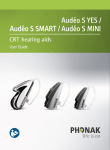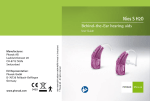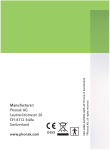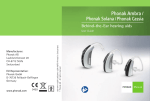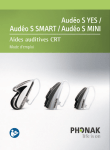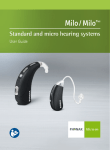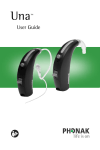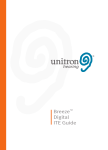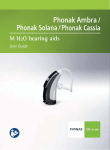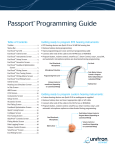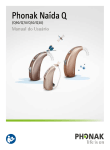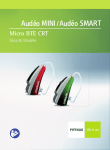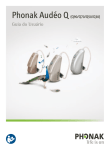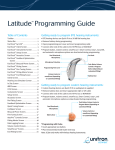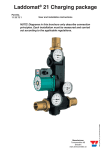Download Audéo S - Phonak
Transcript
PHO_Audeo_S_029-0048-03 Proof.indd 1 6/16/11 3: Contents 1. Welcome 4 2. Important safety information: Please read before operating your hearing system for the first time 6 5. C Hazard warnings 6 Information on product safety 8 6. T 3. Hearing system description 10 7. W 4. Step-by-step instructions for using the hearing system 14 Step 1. Getting to know your hearing system 14 Step 2. Battery preparation 16 Step 3. Inserting the battery 17 9. C 10. Step 4. Turning on the hearing system 17 Step 5. Inserting the hearing system 19 Step 6. Adjusting the volume control behind the ear 21 Step 7. Selecting the hearing program behind the ear 23 8. S 11. 2 PHO_Audeo_S_029-0048-03 Proof.indd 2 6/16/11 3: 4 6 6 8 10 14 14 Step 8. Removing the hearing system 24 Step 9. Turning off the hearing system 25 Step 10. Changing the battery 25 5. Care and maintenance 26 6. Troubleshooting 28 7. Wireless Accessories and FM systems 29 Wireless Accessories 29 FM systems 30 8. Service and warranty 31 17 9. Compliance information 32 17 10. Information and explanation of symbols 35 11. For US market only 38 16 19 21 23 PHO_Audeo_S_029-0048-03 Proof.indd 3 3 6/16/11 3: 1. Welcome Your new hearing system is a premium Swiss quality product. It was developed by Phonak, one of the world‘s leading companies in hearing technology. Your hearing system offers the most modern digital hearing technology currently available on the market. Please read these user instructions thoroughly in order to benefit from all the possibilities your new hearing system has to offer. With proper use and care, you will be able enjoy your hearing system for many years to come. If yo care Pho 045 4 PHO_Audeo_S_029-0048-03 Proof.indd 4 6/16/11 3: y our ng der g will o If you have any questions, please consult your hearing care professional. Phonak - life is on www.phonak-us.com 0459 PHO_Audeo_S_029-0048-03 Proof.indd 5 5 6/16/11 3: PHO_Audeo_S_029-0048-03 Proof.indd 6 I 6/16/11 3: Hearing system batteries are toxic if they are swallowed! Keep out of reach of children and pets. If batteries are swallowed, consult your physician immediately! If you feel pain in or behind your ear, if it is inflamed or if skin irritation and accelerated accumulations of ear wax occur, please check with your hearing care professional or physician. In very rare cases, the dome can remain in your ear canal when removing the hearing tube from the ear. In the unlikely case that the dome does get stuck in your ear canal, it is strongly recommended to see a physician for safe removal. Hearing programs in the directional microphone mode reduce background noises. Please be aware that warning signals or noises coming from behind, e. g. cars, are partially or entirely suppressed. The hearing system contains small parts which can be swallowed by children. PHO_Audeo_S_029-0048-03 Proof.indd 7 7 6/16/11 3: 2. Important safety information External devices may only be connected if they have been tested in accordance with corresponding IECXXXXX standards. Only use accessories approved by Phonak AG. 2.2 Information on product safety Never immerse your hearing system in water! Protect it from excessive moisture. Always remove your hearing system before showering, bathing, or swimming. Protect your hearing system from heat (never leave near a window or in the car.) Never use a microwave or other heating devices to dry your hearing system. Ask your hearing care professional about suitable drying methods. When you are not using your hearing system, leave the battery compartment open so that any moisture can evaporate. Make sure that you always completely dry your hearing system after use. Store the hearing system in a safe, dry and clean place. 8 PHO_Audeo_S_029-0048-03 Proof.indd 8 6/16/11 3: ave Do not drop your hearing system! Dropping onto a hard surface can damage your hearing system. ed ove , ave ing Always use new batteries for your hearing system. You can return used batteries to your hearing care professional. Remove the battery if you are not using your hearing system for a long period of time. X-ray radiation (e. g. CT scans, MRI scans) may adversely affect the correct functioning of your hearing systems. We recommend that you remove them before undergoing X-ray procedures and keep them outside the room. Do not use your hearing system in areas where electronic equipment is prohibited. ny er d PHO_Audeo_S_029-0048-03 Proof.indd 9 9 6/16/11 3: 3. Hearing system description The following user instructions describe Canal Receiver Technology (CRT) hearing system models. CRT hearing systems can be adapted with a variety of earpieces. Opt On the following pages use the labeled drawings to identify the earpiece that you use. Your hearing care professional will tell you what size of battery you need for your hearing system. Aud * Op an 10 PHO_Audeo_S_029-0048-03 Proof.indd 10 6/16/11 3: iver of Option A: with Dome to e Audéo S YES Audéo S SMART Audéo S MINI Earpiece: Dome Retention xReceiver unit Microphone input with microphone protector Switch* Battery compartment with ON/OFF switch * Option/Function not available for Audéo S YES and Audéo S MINI PHO_Audeo_S_029-0048-03 Proof.indd 11 11 6/16/11 3: 3. Hearing system description Option B: with Shell Opt Audéo S YES Audéo S SMART Audéo S MINI Earpiece: shell (cShell/xShell) xReceiver unit Microphone input with microphone protector Switch* Battery compartment with ON/OFF switch * Option/Function not available for Audéo S YES and Audéo S MINI Aud * Op an 12 PHO_Audeo_S_029-0048-03 Proof.indd 12 6/16/11 3: Option C: with SlimTip Audéo S YES Audéo S SMART Audéo S MINI Removal handle Earpiece: SlimTip xReceiver unit Microphone input with microphone protector Switch* Battery compartment with ON/OFF switch * Option/Function not available for Audéo S YES and Audéo S MINI PHO_Audeo_S_029-0048-03 Proof.indd 13 13 6/16/11 3: 4. Step-by-step instructions for using the hearing system The following chapter provides step-by-step instructions on how to use your hearing system. Please follow these steps carefully. In the drawings, the parts that are particularly important for each step are shown in green. Step 1. Getting to know your hearing system Take the hearing instrument in your hand and try out the hearing system controls. This will make it easier for you to feel for and operate the controls later on when wearing the hearing system. You syst prog to d syst Volu To i hea on y Dec volu Fig. * Op an 14 PHO_Audeo_S_029-0048-03 Proof.indd 14 6/16/11 3: ons at ut for en Your hearing care professional can configure your hearing system (push) switch as either a volume control or a program selector. Consult your hearing care professional to determine which option is active in your hearing system. Volume control option To increase the volume, press the switch on your right hearing system. To decrease the volume, press the switch on your left hearing system (Fig. 1a).* Decrease volume Left hearing system Increase volume Right hearing system Fig. 1a * Option/Function not available for Audéo S YES and Audéo S MINI PHO_Audeo_S_029-0048-03 Proof.indd 15 15 6/16/11 3: 4. Using your hearing system Hearing program option In order to change a hearing program, press the switch displayed (Fig. 1b).* Step Take batt + sy Fig. 1b Step 2. Battery preparation Fig. Remove the protective foil from the new battery (Fig. 2). Wait for two minutes before inserting to activate the battery. Step The com Fig. 2 * Option/Function not available for Audéo S YES and Audéo S MINI Fig. 16 PHO_Audeo_S_029-0048-03 Proof.indd 16 6/16/11 3: Step 3. Inserting the battery Take the hearing system in your hand and open the battery door. Insert the battery so that you see the + symbol on the battery (Fig. 3a/3b). Fig. 3a: Audéo S YES . 2). he Fig. 3b: Audéo S SMART Audéo S MINI Step 4. Turning on the hearing system The hearing system is switched on by closing the battery compartment (Fig. 4a/4b). d Fig. 4a: Audéo S YES PHO_Audeo_S_029-0048-03 Proof.indd 17 Fig. 4b: Audéo S SMART Audéo S MINI 17 6/16/11 3: 4. Using your hearing system Open and close the battery compartment gently and carefully. Check if you feel resistance when closing the battery compartment. Check to make sure the battery is correctly inserted and in the correct direction. If the battery is inserted the wrong way, the hearing system will not work and the battery compartment can be damaged. The hearing system is now switched on. It can take up to 15 seconds before it starts. (When you wear the hearing system, you will hear an acoustic signal). Step This syst hea Step and Colo righ left Fig. 18 PHO_Audeo_S_029-0048-03 Proof.indd 18 6/16/11 3: ly ct he Step 5. Inserting the hearing system This step shows you how to correctly insert the hearing system. The type of earpiece determines how the hearing system is inserted. Each hearing system is individually programmed for your right or left ear. For the first step identify right and left so you will be able to insert your hearing system in the correct ear. up an Step 5.1 Identifying the hearing systems for the right and left ear Color indicator: right = red left = blue Fig. 5a: Audéo S YES PHO_Audeo_S_029-0048-03 Proof.indd 19 Fig. 5b: Audéo S SMART Audéo S MINI 19 6/16/11 3: 4. Using your hearing system Step 5.2 Inserting a hearing system with a dome With your right hand, place the right hearing system (red mark on the hearing system, see step 5.1) behind your right ear (Fig. 5c). Place the hearing tube between your thumb and forefinger. Insert the dome deep enough into the ear canal so that the hearing tube lies flat on your ear (Fig. 5d). If your hearing system has a retention cord, then press it into the bowl of the ear in order to retain the dome in the ear canal (Fig. 5e). If yo you This grad You syst sam Step or S Foll iden Step You syst prog Fig. 5c Fig. 5d Fig. 5e * Op an 20 PHO_Audeo_S_029-0048-03 Proof.indd 20 6/16/11 3: em d en ugh n tion to If you have problems inserting the hearing system, use your other hand to gently pull your earlobe downwards. This opens the ear canal a little more and you can gradually rotate the dome until it fits correctly. You have now successfully inserted the right hearing system. Now insert your left hearing system in the same way (marked in blue, see step 5.1) Step 5.3 For inserting a hearing system with a SlimTip or Shell Follow the instructions in Step 5.2, as this procedure is identical. Step 6. Adjusting the volume control behind the ear* Your hearing care professional can configure your hearing system (push) switch as either a volume control or a program selector. * Option/Function not available for Audéo S YES and Audéo S MINI PHO_Audeo_S_029-0048-03 Proof.indd 21 21 6/16/11 3: 4. Using your hearing system To increase the volume, press the switch on your right hearing system. To decrease the volume, press the switch of your left hearing system. Use your thumb to lightly support the hearing system (Fig. 6). Left hearing system Right hearing system Decrease volume Increase volume Step In o the disp Fig. If yo A si A si on t beh Fig. 6 * Op Au 22 PHO_Audeo_S_029-0048-03 Proof.indd 22 6/16/11 3: t itch Step 7. Selecting the hearing program behind the ear* In order to select or change a hearing program with the standard hearing system, press the program switch displayed in (Fig. 7). m Fig. 7 If you press it again, you change to the next program. A signal indicates the change. A signal tone can only be easily heard if you have turned on the hearing system and you are wearing it correctly behind the ear. * Option/Function not available for Audéo S YES and Audéo S MINI PHO_Audeo_S_029-0048-03 Proof.indd 23 23 6/16/11 3: 4. Using your hearing system Step 8. Removing the hearing system Step Step 8.1 Removing a hearing system with a dome You batt Grasp the hearing system by the hearing tube and carefully remove it from your ear (Fig. 8). Fig. 8 In very rare cases, the dome can remain in your ear canal when removing the hearing tube from the ear. In the unlikely case that the dome does get stuck in your ear canal, it is strongly recommended to see a medical specialist for safe removal. Step 8.2 Removing a hearing system with SlimTip or Shell Follow the instructions in Step 8.1, as this procedure is identical. Fig. Step Befo syst to b you chan ever a sp 24 PHO_Audeo_S_029-0048-03 Proof.indd 24 6/16/11 3: ur m get ded e Step 9. Turning off the hearing system You can turn off your hearing system by opening the battery compartment (Fig. 9a/9b). Fig. 9a: Audéo S YES Fig. 9b: Audéo S SMART Audéo S MINI Step 10. Changing the battery Before the battery is completely empty, your hearing system will indicate to you that the battery soon needs to be changed with an acoustic signal. Once this happens, you have about 30 minutes (in some cases longer) to change the battery. The battery warning signal is repeated every half hour. We recommend that you always keep a spare battery on hand. PHO_Audeo_S_029-0048-03 Proof.indd 25 25 6/16/11 3: 5. Care and maintenance Diligent and routine care of your hearing system contributes to outstanding performance and a long service life. Please use the following specifications as a guideline: General information Before using hair spray or applying cosmetics, you should remove your hearing system from your ear, because these products may damage it. Never wash or clean the microphone protection (see chapter 3). Doing so could cause it to lose its special acoustic features. Try to avoid touching this protection, e. g. when inserting or operating the hearing system. Dail Insp dep Nev soa nee hea on fi Wee Clea a sp in d basi 26 PHO_Audeo_S_029-0048-03 Proof.indd 26 6/16/11 3: g e: e on, Daily Inspect the earpiece and tube for earwax and moisture deposits. Clean the surfaces with a lint-free cloth. Never use cleaning agents such as household detergents, soap, etc. for cleaning your hearing system. If you need to clean your hearing system intensively, ask your hearing care professional for advice and information on filters or drying capsules. Weekly Clean the earpiece with a soft, damp cloth or with a special cleaning cloth for hearing systems. For more in depth maintenance instructions or for more than basic cleaning, please see your hearing care professional. PHO_Audeo_S_029-0048-03 Proof.indd 27 27 6/16/11 3: 6. Troubleshooting Hearing systems sound softer than usual / no sound First check whether you can adjust and make the sound louder with the volume control. Then check the earpiece for earwax residue and clean if necessary. Check whether the battery is correctly inserted and properly fitted, adjust the fit if necessary. If there is no improvement, change the battery. If the problem persists, contact your hearing care professional. Battery discharges too quickly Insert a new battery and make note of exactly how long it lasts. Contact your hearing care professional with this information, they will be able to help and advise you. Crackling or buzzing background noises Check the earpiece for earwax residue. If the problem persists, contact your hearing care professional. Wh Che fitte con you Pain Rem hea plea 7. 7.1 Pho sori you con com that com 28 PHO_Audeo_S_029-0048-03 Proof.indd 28 6/16/11 3: d he Whistling Check whether the earpiece is correctly and firmly fitted. If this is the case, but the problem persists, please consult with your hearing care professional to check your ear. no al m Pain or inflammation in your ear Remove the hearing system and consult with your hearing care professional. If the problem is serious, please contact your physician. 7. Wireless Accessories and FM systems 7.1 Wireless accessories* Phonak has developed a broad range of wireless accessories that allow you to best use and discreetly control your hearing system. These include, for example, remote controls, wireless connection modules to the TV and computer, and much more. Programs and accessories that can help you make phone calls simply and more comfortably are also included in this product range. PHO_Audeo_S_029-0048-03 Proof.indd 29 29 6/16/11 3: 7. Wireless Accessories and FM systems 8. 7.2 FM systems* FM Systems are wireless communication systems consisting of a radio transmitter and a radio receiver. The transmitter is placed close to the sound source (e. g. TV/Radio/lectern). The sound is transmitted clearly and directly to the hearing system in the form of radio signals – without disruptive background noises or echoes. 8.1 Plea purc war Phonak is a leader in FM communication. In order to take advantage of the benefits of these high-tech radio systems, consult with your hearing care professional. 8.2 Pho vali war the batt war If you already have an FM system and need additional information on using this system, please consult the relevant user instructions on the FM transmitter or the FM receiver. 8.3 This han Dam cent doe prof For more information, please visit www.phonak-us.com, or ask your hearing care professional. Seri * Option/Function not available for Audéo S MINI Seri Dat 30 PHO_Audeo_S_029-0048-03 Proof.indd 30 6/16/11 3: ver. e ly s dio nal e the om, 8. Service and warranty 8.1 Local warranty Please ask the hearing care professional, where you purchased your hearing aid, about the terms of the local warranty. 8.2 International warranty Phonak offers a one year limited international warranty, valid starting from the date of purchase. This limited warranty covers manufacturing and material defects in the hearing aid itself, but not accessories such as batteries, tubes, earmolds, external receivers. The warranty is valid only if proof of purchase is shown. 8.3 Warranty limitation This warranty does not cover damage from improper handling or care, exposure to chemicals or undue stress. Damage caused by third parties or non-authorized service centers renders the warranty null and void. This warranty does not cover any services performed by a hearing care professional in his/her office. Serial number (left side): Serial number (right side): Authorized hearing care professional (stamp/signature): Date of purchase: PHO_Audeo_S_029-0048-03 Proof.indd 31 31 6/16/11 3: 9. Compliance information Declaration of Conformity Hereby Phonak AG declares that this Phonak product meets the requirements of the Medical Devices Directive 93/42/EEC as well as the Radio and Telecommunications Terminal Equipment Directive 1999/5/EC. The full text of the Declaration of Conformity can be obtained from the manufacturer. Important information: Hearing aid usage with cell phones Some hearing aid users have reported a buzzing sound in their hearing aids when they are using cell phones. Please note that the performance of individual hearing aids may vary with individual cell phones. Therefore, please try the hearing aid with your cell phone or, if you are purchasing a new phone, be sure to try it with your hearing aid prior to purchase. For additional guidance, please ask your hearing healthcare professional for the booklet entitled “Hearing Aid Compatibility with Digital Wireless Cell Phones.” According to the ANSI 63.19 (American National Standard Methods of Measurement of Compatibility Between Wireless Communications Devices and Hearing instruments) standard, the compatibility of a particular hearing aid and cell phone can be predicted by adding the rating for the hearing aid immunity to the rating for the cell phone emissions. The sum of the hearing aid rating (e.g. M2/T2=2) and the telephone rating (e.g. M3/T3=3) is 5, and any combination that equals 5 will provide “normal use”; a sum of 6 or greater would indicate “excellent performance.” the equipment performance measurements, categories and system classifications are based upon the best information available but cannot guarantee that all users will be satisfied. The immunity of this hearing aid is at least M2/T2. The cert USA Can Not This with to t 1) t 2) t i o Not Cha exp auth 32 PHO_Audeo_S_029-0048-03 Proof.indd 32 6/16/11 3: ct tive ns t of m nes nd . ng you ur e, he tal t ts) ed by sions. T3=3) ater The hearing instrument described in this user guide is certified under: USA Canada FCC ID: KWC-WHSSAN1 IC: 2262A-WHSSAN1 Notice 1: This device complies with Part 15 of the FCC Rules and with RSS-210 of Industry Canada. Operation is subject to the following two conditions: 1) this device may not cause harmful interference, and 2) this device must accept any interference received, including interference that may cause undesired operation. Notice 2: Changes or modifications made to this device not expressly approved by Phonak may void the FCC authorization to operate this device. but at PHO_Audeo_S_029-0048-03 Proof.indd 33 33 6/16/11 3: 9. Compliance information Notice 3: This device has been tested and found to comply with the limits for a Class B digital device, pursuant to Part 15 of the FCC Rules and ICES-003 of Industry Canada. These limits are designed to provide reasonable protection against harmful interference in a residential installation. This device generates, uses and can radiate radio frequency energy and, if not installed and used in accordance with the instructions, may cause harmful interference to radio communications. However, there is no guarantee that interference will not occur in a particular installation. If this device does cause harmful interference to radio or television reception, which can be determined by turning the equipment off and on, the user is encouraged to try to correct the interference by one or more of the following measures: 10 of XXX Reorient or relocate the receiving antenna. Increase the separation between the device and receiver. Connect the device into an outlet on a circuit different from that to which the receiver is connected. Consult the dealer or an experienced radio/TV technician for help. 34 PHO_Audeo_S_029-0048-03 Proof.indd 34 6/16/11 3: h art a. ion on. 10. Information and explanation of symbols XXXX ul ere a mful can the e rent With the CE symbol, Phonak AG confirms that this Phonak product – including accessories – meets the requirements of the Medical Devices Directive 93/42/EEC as well as the R&TTE Directive 1999/5/EC on radio and telecommunications transmitters The numbers after the CE symbol correspond to the code of certified institutions that were consulted under the above-mentioned directives. This symbol indicates that the products described in these user instructions adhere to the requirements for an application part of Type BF of EN 60601-1. The surface of the hearing system is specified as application part of Type BF. cian PHO_Audeo_S_029-0048-03 Proof.indd 35 35 6/16/11 3: 10. Information and explanation of symbols This symbol indicates that it is important for the user to read and take into account the relevant information in these user guides. Tran and con This symbol indicates that it is important for the user to pay attention to the relevant warning notices in these user guides. Important information for handling and product safety. Operating conditions The product is designed such that it functions without problems or restrictions if used as intended, unless otherwise noted in these user guides. 36 PHO_Audeo_S_029-0048-03 Proof.indd 36 6/16/11 3: nd Transport and storage conditions poro ese ng t ess des. PHO_Audeo_S_029-0048-03 Proof.indd 37 During transport or storage, the temperature should not exceed the limit values of -20°/60° Celsius and relative humidity of 65% for a long period of time. The air pressure between 500 and 1100 hPa is appropriate. The symbol with the crossed-out garbage bin is to make you aware that this hearing system may not be thrown away as normal household waste. Please dispose of old or unused hearing systems, at waste disposal sites intended for electronic waste, or give your hearing system to your hearing care professional for disposal. Proper disposal protects the environment and health. 37 6/16/11 3: For the US market only, complies with the FDA regulations (vii) Warning to Hearing Aid Dispensers (viii A hearing aid dispenser should advise a prospective hearing aid user to consult promptly with a licensed physician (preferably an ear specialist) before dispensing a hearing aid if the hearing aid dispenser determines through inquiry, actual observation, or review of any other available information concerning the prospective user, that the prospective user has any of the following conditions: (i) Visible congenital or traumatic deformity of the ear. (ii) History of active drainage from the ear within the previous 90 days. (iii) History of sudden or rapidly progressive hearing loss within the previous 90 days. (iv) Acute or chronic dizziness. (v) Unilateral hearing loss of sudden or recent onset within the previous 90 days. (vi) Audiometric air-bone gap equal to or greater than 15 decibels at 500 hertz (Hz), 1,000 Hz, and 2,000 Hz. Imp Hea Goo hea phy in d Lice ear or o eva 38 PHO_Audeo_S_029-0048-03 Proof.indd 38 6/16/11 3: ve d sing s ny ve wing ng set and (vii) Visible evidence of significant cerumen accumulation or a foreign body in the ear canal. (viii) Pain or discomfort in the ear. Special care should be exercised in selecting and fitting a hearing aid whose maximum sound pressure level exceeds 132 decibels because there may be risk of impairing the remaining hearing of the hearing aid user. (This provision is required only for those hearing aids with a maximum sound pressure capability greater than 132 decibels (dB).) Important Notice for Prospective Hearing Aid Users Good health practice requires that a person with a hearing loss have a medical evaluation by a licensed physician (preferably a physician who specializes in diseases of the ear) before purchasing a hearing aid. Licensed physicians who specialize in diseases of the ear are often referred to as otolaryngologists, otologists or otorhinolaryngologists. The purpose of medical evaluation is to assure that all medically treatable PHO_Audeo_S_029-0048-03 Proof.indd 39 39 6/16/11 3: For US market only conditions that may affect hearing are identified and treated before the hearing aid is purchased. Following the medical evaluation, the physician will give you a written statement that states that your hearing loss has been medically evaluated and that you may be considered a candidate for a hearing aid. The physician will refer you to an audiologist or a hearing aid dispenser, as appropriate, for a hearing aid evaluation. The audiologist or hearing aid dispenser will conduct a hearing aid evaluation to assess your ability to hear with and without a hearing aid. The hearing aid evaluation will enable the audiologist or dispenser to select and fit a hearing aid to your individual needs. If you have reservations about your ability to adapt to amplification, you should inquire about the availability of a trial-rental or purchase-option program. Many hearing aid dispensers now offer programs that permit you to wear a hearing aid for a period of time for a nominal fee after which you may decide if you want to purchase the hearing aid. Fed indi from info the that exer inte Chi In a eva dire reha in la soci trai and 40 PHO_Audeo_S_029-0048-03 Proof.indd 40 6/16/11 3: l t r g ct ar to . to lity Federal law restricts the sale of hearing aids to those individuals who have obtained a medical evaluation from a licensed physician. Federal law permits a fully informed adult to sign a waiver statement declining the medical evaluation for religious or personal beliefs that preclude consultation with a physician. The exercise of such a waiver is not in your best health interest and its use is strongly discouraged. Children with Hearing Loss In addition to seeing a physician for a medical evaluation, a child with a hearing loss should be directed to an audiologist for evaluation and rehabilitation since hearing loss may cause problems in language development and the educational and social growth of a child. An audiologist is qualified by training and experience to assist in the evaluation and rehabilitation of a child with a hearing loss. mit t to PHO_Audeo_S_029-0048-03 Proof.indd 41 41 6/16/11 3: Notes 42 PHO_Audeo_S_029-0048-03 Proof.indd 42 6/16/11 3: PHO_Audeo_S_029-0048-03 Proof.indd 43 6/16/11 3: PHO_Audeo_S_029-0048-03 Proof.indd 44 6/16/11 3:












































